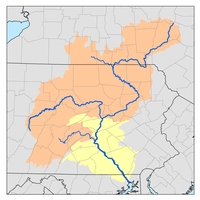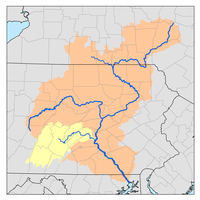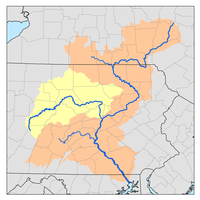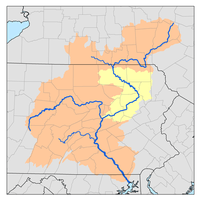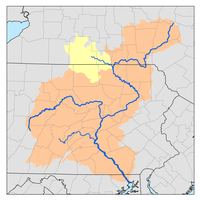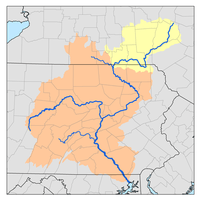Little Pine Creek
Little Pine Creek is a tributary of Pine Creek in Lycoming County, Pennsylvania, in the United States. It is approximately 15.8 miles (25.4 km) long and flows through Pine Township and Cummings Township.[1]
Course
Little Pine Creek begins at the confluence of Texas Creek and Blockhouse Creek in Pine Township. It flows roughly southwest, parallel to Pennsylvania Route 284 and receives the tributaries Bear Run, Bonell Run, and Lick Run. The creek then passes through English Mills. Further downstream, it receives the tributaries Coal Run, Callahans Run, and Otter Run. The creek then enters Cummings Township, where it passes through a dam known as the Little Pine Dam. On the southern side of the dam, it turns south and meanders several miles until it crosses Pennsylvania Route 44 and reaches its confluence with Pine Creek.[1]
Little Pine Creek joins Pine Creek 13.84 miles (22.27 km) upstream of its mouth.[2]
Geography and watershed
The watershed of Little Pine Creek has an area of 180 square miles (470 km2).[2]
Little Pine Creek is said to resemble a smaller version of Pine Creek. The velocity of its waters is also faster than those of Pine Creek. The creek's valley is narrow and resembles a canyon in its lower reaches. Groves of sycamore and summer camps are found along the valley.[3]
A dam that is 120 feet (37 m) high is on Little Pine Creek.[3]
Recreation
It is possible to canoe on 15.6 miles (25.1 km) of Little Pine Creek during snowmelt or within four days of heavy rain. The difficulty rating of the creek is between A and 2-. The scenery along it is described as "good" by Edward Gertler in his book Keystone Canoeing.[3]
Little Pine Creek flows through Little Pine Creek State Park for part of its length.[3]
See also
References
- United States Geological Survey, The National Map Viewer, archived from the original on April 5, 2012, retrieved September 16, 2014
- Pennsylvania Gazetteer of Streams (PDF), November 2, 2001, retrieved September 16, 2014
- Edward Gertler (1984), Keystone Canoeing, Seneca Press, p. 310
External links
| Wikimedia Commons has media related to Little Pine Creek. |
